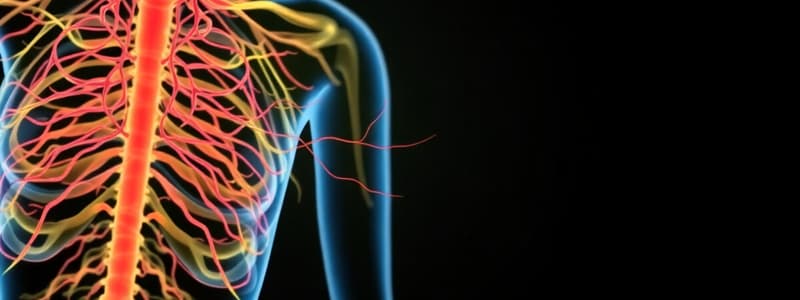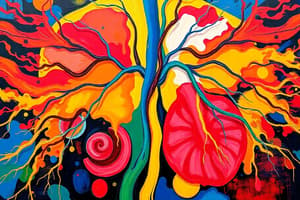Podcast
Questions and Answers
What is the primary function of the sympathetic division of the autonomic nervous system?
What is the primary function of the sympathetic division of the autonomic nervous system?
- To regulate digestive functions
- To promote repair and recovery
- To prepare the body for activity (correct)
- To preserve energy in the body
Which neurotransmitter is commonly released by postganglionic neurons in the sympathetic nervous system?
Which neurotransmitter is commonly released by postganglionic neurons in the sympathetic nervous system?
- Noradrenaline (correct)
- GABA
- Dopamine
- Serotonin
What is the primary role of the parasympathetic division during rest?
What is the primary role of the parasympathetic division during rest?
- Promoting energy expenditure
- Increasing heart rate
- Dilating pupils
- Allowing repair and recovery (correct)
How does sympathetic mass stimulation affect the body?
How does sympathetic mass stimulation affect the body?
What ratio of preganglionic fibers to postganglionic fibers is associated with the sympathetic nervous system?
What ratio of preganglionic fibers to postganglionic fibers is associated with the sympathetic nervous system?
What type of myelination do sympathetic preganglionic neurons have?
What type of myelination do sympathetic preganglionic neurons have?
What characterizes the function of autonomic ganglia?
What characterizes the function of autonomic ganglia?
What type of fibers are postganglionic neurons in the autonomic nervous system?
What type of fibers are postganglionic neurons in the autonomic nervous system?
What is the ratio of preganglionic fibers to postganglionic fibers in the parasympathetic nervous system?
What is the ratio of preganglionic fibers to postganglionic fibers in the parasympathetic nervous system?
Which of the following ganglia lie closely related to the aorta and its branches?
Which of the following ganglia lie closely related to the aorta and its branches?
Which type of ganglia is interconnected by nerve fibers and located on both sides of the spinal cord?
Which type of ganglia is interconnected by nerve fibers and located on both sides of the spinal cord?
What is the main characteristic of sympathetic postganglionic fibers?
What is the main characteristic of sympathetic postganglionic fibers?
Which ganglion is NOT associated with the autonomic nervous system?
Which ganglion is NOT associated with the autonomic nervous system?
Which of the following statements is true regarding the adrenal medulla?
Which of the following statements is true regarding the adrenal medulla?
What type of fibers are present in the parasympathetic nervous system?
What type of fibers are present in the parasympathetic nervous system?
Which characteristic is true for the sympathetic nervous system?
Which characteristic is true for the sympathetic nervous system?
What is a key function of the parasympathetic?
What is a key function of the parasympathetic?
What type of chemical transmitter is released by postganglionic neurons of the sympathetic nervous system?
What type of chemical transmitter is released by postganglionic neurons of the sympathetic nervous system?
What is the myelination type of postganglionic neurons in the autonomic nervous system?
What is the myelination type of postganglionic neurons in the autonomic nervous system?
Which of the following roles does the sympathetic nervous system primarily serve?
Which of the following roles does the sympathetic nervous system primarily serve?
What is the primary difference in the effects of sympathetic and parasympathetic mass stimulation?
What is the primary difference in the effects of sympathetic and parasympathetic mass stimulation?
What best describes the 'Fight or Flight' response associated with the sympathetic nervous system?
What best describes the 'Fight or Flight' response associated with the sympathetic nervous system?
What is a characteristic of collateral (pre-vertebral) ganglia in terms of their location?
What is a characteristic of collateral (pre-vertebral) ganglia in terms of their location?
Which statement accurately describes the structure of terminal ganglia?
Which statement accurately describes the structure of terminal ganglia?
Which of the following is a distinguishing feature of the sympathetic nervous system compared to the parasympathetic system?
Which of the following is a distinguishing feature of the sympathetic nervous system compared to the parasympathetic system?
What is unique about the adrenal medulla in regards to sympathetic innervation?
What is unique about the adrenal medulla in regards to sympathetic innervation?
How does the ratio of preganglionic to postganglionic fibers in the parasympathetic system compare to that in the sympathetic system?
How does the ratio of preganglionic to postganglionic fibers in the parasympathetic system compare to that in the sympathetic system?
Which type of fibers are associated with the lateral (para-vertebral) ganglia?
Which type of fibers are associated with the lateral (para-vertebral) ganglia?
Which ganglia are NOT typically associated with the sympathetic nervous system?
Which ganglia are NOT typically associated with the sympathetic nervous system?
What is the effect of having a 1:2 ratio of preganglionic to postganglionic fibers in the parasympathetic nervous system?
What is the effect of having a 1:2 ratio of preganglionic to postganglionic fibers in the parasympathetic nervous system?
Flashcards are hidden until you start studying
Study Notes
Autonomic Nervous System (ANS)
- The ANS regulates involuntary or visceral functions in the body.
- Divided into two branches: Sympathetic & Parasympathetic.
- Sympathetic: "Fight or Flight"
- Prepares the body for activity, increasing capacity for effort in response to stress.
- Delays onset of fatigue in contracting muscles.
- Mass stimulation is useful.
- Increases energy expenditure.
- Catabolic to energy.
- Parasympathetic: "Rest and Digest"
- Predominates during rest and sleep.
- Allows for repair and recovery of contracting muscles.
- Mass stimulation may be fatal.
- Preserves energy in the body.
- Anabolic to energy.
Course of the ANS
- Composed of Preganglionic & Postganglionic neurons
- Preganglionic neurons originate inside the CNS
- Postganglionic neurons originate outside the CNS in autonomic ganglia.
- Both types end at effector organs.
- Preganglionic neurons:
- Thin and myelinated (type B).
- Fewer in number.
- Use acetylcholine (Ach) as a neurotransmitter.
- Postganglionic neurons:
- Non-myelinated (type C).
- More numerous
- Use Ach or noradrenaline as a neurotransmitter.
Autonomic Ganglia
- Collections of cell bodies of neurons outside the CNS.
- Functions:
- Relay station for autonomic preganglionic nerve fibers.
- Distributing center.
- Sympathetic:
- Ratio of preganglionic to postganglionic fibers is 1:32.
- Has generalized effects.
- Parasympathetic:
- Ratio of preganglionic to postganglionic fibers is 1:2.
- Has localized effects.
- Sympathetic:
- Adrenal Medulla: The only sympathetic effector organ directly innervated by preganglionic nerve fibers.
Types of Ganglia
- Lateral (Para-Vertebral)
- Located on both sides of the spinal cord.
- Interconnected by nerve fibers, forming the sympathetic chain.
- Short preganglionic and long postganglionic fibers.
- Classified according to spinal segment: 3 cervical, 12 thoracic, 5 lumbar, 5 sacral, 1 coccygeal.
- Collateral (Pre-Vertebral)
- Located mainly in the abdomen, midway between the spinal cord and viscera.
- Preganglionic fibers are equal in length to postganglionic fibers.
- Closely related to the aorta and its branches, named accordingly: Celiac, Superior Mesenteric, Inferior Mesenteric, Aortico-renal.
- Terminal
- Located close to or at the wall of effector organs.
- Long preganglionic and short postganglionic fibers.
- Contain all parasympathetic fibers.
Sympathetic vs. Parasympathetic
- Sympathetic:
- Short preganglionic and long postganglionic fibers.
- Parasympathetic:
- Long preganglionic and short postganglionic fibers.
Autonomic Nervous System (ANS)
- The ANS regulates involuntary or visceral functions of the body.
Divisions of the ANS
-
Sympathetic Nervous System: "Fight or flight"
- Prepares body for activity
- Delays onset of fatigue
- Mass stimulation is useful
- Increases energy expenditure
- Catabolic to energy
-
Parasympathetic Nervous System: "Rest and digest"
- Predominates during rest and sleep
- Allows for repair and recovery
- Mass stimulation can be fatal
- Preserves energy
- Anabolic energy
Structure of the ANS
-
The ANS has two neurons:
- Preganglionic neuron: Originates inside the CNS
- Postganglionic neuron: Originates outside the CNS, in autonomic ganglia
- End: At effector organs
-
Preganglionic neuron characteristics:
- Thin myelinated type B
- Few in number
- Chemical transmitter: acetylcholine
-
Postganglionic neuron characteristics:
- Non-myelinated type C
- More in number
- Chemical transmitter: acetylcholine or noradrenaline
Autonomic Ganglia
- Collection of cell bodies of neurons outside the CNS (peripheral nervous system)
- Functions:
- Relay station for autonomic preganglionic nerve fibers
- Distributing center
Types of Ganglia
-
Lateral (Para-Vertebral) Ganglia:
- On both sides of the spinal cord
- Interconnected by nerve fibers, forming the sympathetic chain
- Short preganglionic fibers and long postganglionic fibers
-
Collateral (Pre-Vertebral) Ganglia:
- Present mainly in the abdomen
- Located midway between the spinal cord and viscera
- Preganglionic fibers are about the same length as postganglionic fibers
-
Terminal Ganglia:
- Lie close to or at the wall of effector organs
- Long preganglionic fibers and short postganglionic fibers
Locations of Ganglia
-
Lateral Ganglia:
- 3 Cervical: superior, middle, inferior
- 12 Thoracic
- 5 Lumbar
- 5 Sacral
- 1 Coccygeal
-
Collateral Ganglia:
- Celiac ganglion
- Superior mesenteric ganglion
- Inferior mesenteric ganglion
- Aortico-renal ganglion
Sympathetic vs Parasympathetic
- Sympathetic: Short preganglionic and long postganglionic fibers
- Parasympathetic: Long preganglionic and short postganglionic fibers
- Adrenal Medulla: Unique effector organ in the sympathetic system directly innervated by preganglionic fibers
Studying That Suits You
Use AI to generate personalized quizzes and flashcards to suit your learning preferences.




